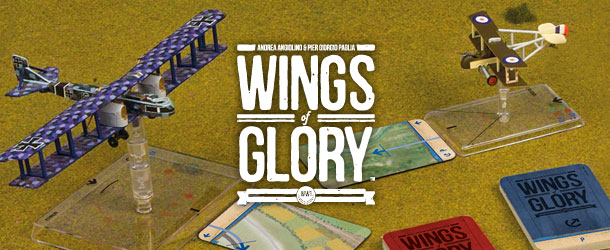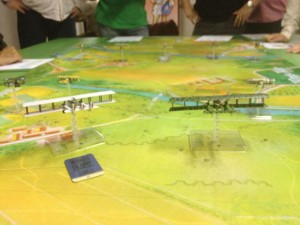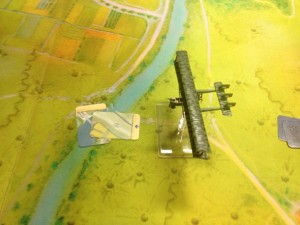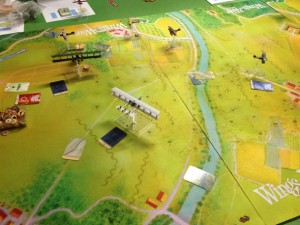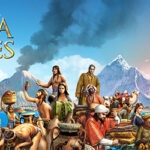The recently released bomber Caproni Ca.3 took off at Rome piloted by one of the Wings of Glory authors, Andrea Angiolino. See below his report of this game session.
"I opened my Special Packs for the first time on June 1 at the Miles Gloriosus, a famed Roman wargame club where several fond players gather: a real paradise for a wargamer. I had been invited for a session of Wings of Glory with the samples of the Caproni Ca.3 I had just received as game author. Some of the players who joined me at the table were novices of the game system, some were veterans from a long Wings of War campaign held last year.
For novices' sake, Wings of Glory's standard rules were adopted with no altitude nor options: just the one about multiple hits on crew. A house rule was in use: to fire, target models had to be reached by the ruler instead than bases. To avoid too early departures from the gaming table, explosions were considered half the original damage value of the plane - as an example, for an Albatros capable of bearing 15 points of damage an explosion was worth 8 damages.
Victory conditions were to be reached scoring victory points: 12 of them for every enemy fighter eliminated (shot down or gone out of the gaming field), 20 for each Caproni eliminated, 6 to "Italians" (actually a varied Allied force) for each target fully hit, 3 for each target partially hit. Italians could exit from their own side without penalty after the bombing.
The battle was held on three game mats, one beside the other. Four targets were scattered on one of them, in Austrian territory. Three German D.Va and two Austrian D.III were lined in defense between this and the central mat. At the opposite side of the third mat, two Caproni were placed each with two loads of bombs. An escort composted by two SPAD XIII and two Camel was with them.
I took the controls of one of the two Caproni, the green camouflaged one, with French markings, and the game started. Italian and British fighters went full throttle on toward the enemies, with the Caproni coming slowly behind. The SPAD confirmed to be the quickest fighter of the conflict, leaving even the Camels behind.
Big clash at the center of the table, then the Austro-German were on the Caproni and under the fire of their frontal single machineguns: both Baracca and Jentsch were very soon wounded and on fire, while the huge bombers suffered much lead without apparent damage. But both the pilots survived and kept on fighting. These brave men did epic feats, but I am not able to report them in detail since I could not see well from my Caproni cockpit. And I was very concentrated on the boat bridge on sight, which I had to destroy to stop the Austrian offensive.
The battle was at first fought mainly behind the Italian lines, keeping most of the Germans busy there. At the same time, it also attracted new airplanes: a D.Va on the German side and a Camel on the Allied one (players arriving late at the club). The Caproni split and went on against the two nearest targets. Two or three Albatros, including the newcomer, were still on them, with the Caproni gunners furiously defending the bombers against the twin machineguns of the fighters.
While the first Albatros went down to the ground, my camouflaged Caproni tried to drop his first load of bombs. With more than some luck, it perfectly hit a bridge (it is easy to design bombing rules when you are at your desk, far harder to apply them successfully on the battlefield!).
The white Caproni did the same on his first target, on the Austrian river bank, but for a matter of very few millimeters (of very few meters in 1:144 scale) it missed the center of the target and scored a partial hit.
At the next movement phase, the white Caproni dropped his second load too on the same target, scoring a second partial hit and so totally silencing the target. At the same time, the camouflaged Caproni slowly turned against his second target, a road junction in the woods.
The dogfight still raged, other planes with black crosses went down to the ground thanks both to the escort and to the unresting bombers gunners. While the white Caproni prepared to turn toward the home airfield, the quite damaged green one tried to do his best to fend the attacks of Udet's D.Va and to fly over the road junction (hard to do a sideslip when you have to build it with two turns and a stall or straight...). But it arrived on it too on the right side. The crew decided to drop the bombs anyway with a partial hit, thinking that there was no time to try a second bomb run or to attack the fourth target - a far off railway line.
The Caproni then turned toward the homeland on the path of the white colleague. But Udet was still on his tail and managed to set the bomber on fire, while keeping it under the aim of his twin machineguns.
In the end, Udet was shot down by the crossfire of Baracca's SPAD and the Caproni rear gunner (actually the SPAD shot was enough, no even need to draw the contemporary damage from the Caproni), while the other last German plane was centered by the other Caproni's front gunner. The sky was cleared.
The green Caproni had already suffered 22 points of damage, out of the 25 it could stand. No enemy was on the table any more. My poor bomber just had to draw a last A card from fire damage at the start of the next turn and then the flames would be extinguished. Card taken and... a 4! Among the cries of joy of the Austrian troops on the ground, the green giant went down and become a smoking wreck on the Piave river's banks.
In the end: all German/Austrian planes destroyed, a SPAD and a Caproni lost by the Allied side, two targets fully destroyed (one with a full center and one with two partial hits), a third target partially hit and the fourth target undamaged.
Great fun, if I may say it."

